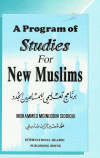A program Of Studies For new Muslims

PART V
V: CULTURAL HISTORY OF ISLAM
V-200 HISTORY OF RELIGIOUS THOUGHT AND PRACTICE
- Tafsir of the Qur'an
1.1 Meaning of tafsir. Principles oftafsir (or tawil). Need for tafsir. Tafsir as one of the functions of messengership.
1.2 Companions ofthe Prophet: Abu,Bakr, 'Umar, 'Uthman, 'Ali, 'Aishah, Ibn Mas'ud, Ibn 'Abbas, Ibn K'ab, Ibn Zubair, Abu Musa.
1.3 Famous tafsirs: Tabari, al-Ash'ari, Zamakhshari, al-Razi, al-Baydawi, Ibn Kathir, al-Suyuti, Jalalayn.
1.4 Recent tafsirs: Tantawi, Syyed Qutb, Maududi, Said Noorsi.
1.5 Dangers of far-fetched tawil: words lose meanings; no solid foundation.
- The Hadith
2.1 Hadith during the Prophet's time.
2.2 Companions: Abu Bakr's and 'Umar's attitudes. Abu Huraira, 'Aishah, Ibn 'Abbas, Ibn Mas'ud, Anas.
2.3 Compilations of hadith: "Al-Muwatta" of Malik and "Al-Musnad" of Ahmad Hanbal. The two "Sahihs" of Bukhari and Muslim. "The Six Sahihs." Other collections.
2.4 The science of critical biography. "Tabaqat" of Ibn s' ad.
- The Fiqh
3.1 The meaning of Fiqh. The Qur'an and Hadith as the main sources. Other sources: analogy, concensus, considered opinion.
3.2 The Companions: 'Umar, 'Ali, Ibn 'Abbas, 'Aishah.
3.3 The Qur'an and Hadith as Sources of legal judgments judgments during the period of the Khulafah al-Rashidoon and during the Umayyah period.
3.4 Formalization of Fiqh. Major schools: Maliki, Hanifi, Shafi'i, and Hanibali. Other schools: J'afari, Zahiri, and 'Ibadi.
3.5 Harun al-Rashid adopts hanafifiqh. "Kitab al-kharaj" of Abu Yusuf. Popularity of the various schools.
3.6 Principles of ijtihad. Knowledge and understanding of the Qur'an and Hadith; knowledge of subject matter; consistency with other principles of Shari'ah; the principle of istihsa; the concept of dururah (Necessity and duress).
4 .The Kalam
4.1 Hadiths concerning speculation in theology.
4.2 What kinds of rational debates are permissible: the attributes of Allah, their perfection; the relationship between man and Allah; the nature of human knowledge.
4.3 Hasan al-Basri, M'utazilah, al-Ash'ari.
4.4 The philosophy: al-Razi, al-Farabi, Ibn Sina, Ibn Rushd. Al-Ghazzali's "Incoherence of the Philosophers."
- The Theories of Leadership
5.1 The Prophet's various roles: bearer of revelation and its expounder, example in character and conduct, teacher of beliefs and religious practices, titular head of the Muslim community, commander-in-chief, chief judge.
5.2 Succession in Prophetic roles: 'ulama as successors in religious teaching, khulafah as successors in the political sphere, faqihs as successors in legislation, qadis as successors in settling disputes and determining punishments.
5.3 The characteristics sought in a political leader.
5.4 Islamic democracy. The sovereignty of Allah; obedience to Allah and His Prophet; election of the ruler; principle of consultation and advice (shura).
5.5 The development of political theories: the emergency of monarchy; khalifah and sultans; the role of 'ulama; the Shaikh al-Islam during 'Uthmaniyah and Mughal periods.
5.6 The Shi'a theory of Imamat. The Khariji theory. Rebellions and failures.
5.7 Islamic democracy in modern times. Pakistan, a case study.
- Tasawwuf
6.1 The 'Unity of Allah' from the Qur'an and Hadith: neither monism nor pantheism.
6.2 The concept of 'nearness to Allah' in the Qur'an and Hadith, and the way to attain it.
6.3 The concepts of 'ishan' and poverty (jaqr), purification of self (tazkiyyah), religious practice (riyadah), and detachment from the world as exemplified in the lives of the Prophet and his Companions.
6.4 Islamic tasawwuf taqwa, jihad, and following the Sunnah in its totality.
6.5 Examples of Muslim Sufis: Junayd, 'Abd al-Qadir Jilani, Mu'inuddin Chishti.
6.6 The theory of tariqah. What is praiseworthy and what is reprehensible in it. The dangers: monasticism, limited brotherhoods, association with Allah, contempt of Shari'ah, laziness and easy way out.
V-201 HISTORY OF EDUCATION
- Aims of Muslim Education
1.1 The importance of the knowledge of religion from the Qur'an and Hadith.
1.2 Religious aims: to understand Islamic faith and practice; to develop Islamic personality in morals and manners; to read and understand the Qur'an; study of the Prophet's life and Sunnah; to grasp the dynamic principle of Islam; to be a Muslim by commitment by realizing Islam's perfection and superiority over all man-made systems.
1.3 Secular aims: pursuit of all knowledge as the revelation of the attributes of Allah; to learn some profession or means of livelihood.
1.4 Universality of elementary education.
- The Organization of Education
2.1 The halqah (the circle).
2.2 The maktab (the writing school).
2.3 The mosque school; the bookshop school.
2.4 The madrasah (school of public instruction).
2.5 The university.
- The Curriculum
3.1 Academic: Tafsir, hadith, Fiqh; mathematics, science, medicine, logic and philosophy, language and literature; social sciences, history, geography, political science, law, sociology, psychology.
3.2 Vocational: very comprehensive studies in all applied Sciences.
3.3 University curricula: Shar'iyyat, literary studies, rational studies (including science).
- The Teacher-Pupil Relationship.
- Methods
5.1 Formal lectures, Reading of a text, explaining difficult passages. Three-step presentation: general outline, more depth, singling out difficult portions.
5.2 Memorization by students, repetition of what is memorized, reflection on the content, and application.
5.3 Service of the teacher and close personal association with him.
- Libraries
6.1 Libraries as centers of education. Important Muslim libraries. Their destruction.
- Classification of Subjects.
V-202 CIVIL LIFE
- Cities
1.1 The early settlements: Basra and Kufah in Iraq, Fustat in Egypt, Qayrawan in Maghrib. Baghdad a little later.
1.2 Population: Arab tribes, mawali (the new Muslims), dhimmis. Fusion of different groups in 'Abbasiyyah times.
1.3 The layout of cities: the jan'i the palace of surroundings, the suqs and grouping of trades, quarters for various religious and ethnic groups; city planning, streets, gardens and parks, residential quarters.
1.4 Life in the capital: the khalifah and his court, the princes and the high officials, the bureaucracy. The wazir. Various departments: army, land distribution, treasury, justice. The qadis. The merchants, craftsmen and artisans. Muhtasib. Mosques, schools and colleges. The
servants and slaves. Baths and public places.
- Countryside
2.1 The Muslim world in early period: desert and sub-desert regions, oases, fertile land along the rivers. Water: network of irrigation, wells and wheels, fair distribution of water.
2.2 Nomadism: camel-nomadism and sheep- and cattle nomadism.
2.3 Agriculture: the science of agronomy, development of large estates into gardens. Old methods and crops. Introduction of new crops: mills, sugarcane. New methodology: sugar, flax, cotton, wheat, barley. Fruits and vegetables. Classification of land: subject to kharaj, waqf Large and small estates. Peasants, land owners.
2.4 Mineral resources: iron and copper as the basis of metallurgy; silver and gold. Other minerals: alum and natron, rock salt, stone quarries.
- Industry.
3.1 State-regulated industries: arms and arsenals, papyrus and paper, luxury fabrics, coinage mints.
3.2 Free crafts, numerous and varied. Textiles and textile corporations: workshops, artisans and apprentices. Guilds of craftsmen. Muhtasib.
V-203 ARCHITECTURE AND ART
Note: This course should be taught with slides of buildings and art objects, and if possible with displays of actual art and and craft objects.
- Architecture
1.1 Mosques. Basic elements of a mosque: mihrab) minbar and covered area. Other parts: courtyard, water fountain, minerets, dome, windows.
1.1.1 Prophet's mosque: at the time of the Prophet; later additions; the present mosque. Mosques of early khulafah's time in Basra, Kufa and Fustat. Dome of the Rock and Umayyah mosque in Damascus.
1.1.2 Architecture of the mosque from the time of the Umayyah to the present: structure, mosaics, calligraphy, geometric designs. The concepts of simplicity, unity, abstraction and infinity as expressed in large mosques.
1.1.3 Umayyah, 'Abbasiyyah, Seljuqi, Fatimi, Moorish, Ayyubi, Mamluk, 'Uthmaniyah, Safavi, Mughal and South Asian architecture, with emphasis on their different styles and characteristics. Names of great architects and patrons.
1.2 Tombs and palaces. Umayyah buildings in Jericho, Syria and Jordan. 'Abbasiyyah buildings in Baghdad and vicinity, Alhambra in Granada, Fatimi buildings in Tunis and Cairo, tombs of Seljuqi period in Anatolia and USSR. Safavi. 'Uthmaniyah and Mughal tombs, palaces and public buildings.
1.3 Public works. Famous irrigation works, bridges, karavanserai, madrasahs and universities.
- Arts and Crafts
2.1 Decorative art: on mosques and buildings, on textiles, enamels.
2.2 Pottery: unglazed, glazed, paint, lustre technique.
2.3 Metalwork and woodwork.
2.4 Miniature painting: the Seljuqi, Persian and Mughal schools.
2.5 Calligraphy: Kufi, Naskhi, Nast'aliq.
2.6 Carpets, rugs, brocades, velvet and embroideries.
V-204 HISTORY OF SCIENCE
- Mathematical Sciences.
1.1 Arithmetic. Translations. Hindi-Arabic numerals, Methods of calculation. Thabit ibn Qurra, al-Karaji and al-Kashi.
1.2 Geometry. Translations. Contributions of Abu Kamil, Abu al-Wafa, al-Kuhi, 'Umar Khayyam and Ibn alHa 'ytham. Applications.
1.3 Algebra. The origination. Al-Khwarizmi and 'Umar Khayyam.
1.4 Trigonometry. Invention of Plane and spherical trigonometry. Abu al-Wafa's and al-Battani's
contributions.
1.5 Astronomy. Translations. Al-Farazi, al-Khawarizmi, al-Farghani, al-Battani, al-Zarqali, al-Biruni, Ulugh Beg. Observatories, instruments, theories.
1.6 Applications. Music. Mechanics and hydraulics. Astrology. Daily matters: kharaj) zakat) inheritance, specific gravity.
- Natural Sciences
2.1 Physics. Properties of matter. Studies of sound, light, magnetism, motion, weight and gravity. Al-Kindi, al-Razi, al-Farabi, Ibn al-Ha'ytham, al-Biruni, 'Umar Khayyam.
2.2 Alchemy and chemistry. Chemical properties of matter. Chemical processes. Application of chemical knowledge. Al-Razi, Abu Mansur Muwaffak, Abu al-Qasim, al-Mardini, Ibn Sina.
2.3 Natural history. Plants and animals. AI-Asma'i, 'Ali al- Tabari, al-Dinawari, Ibn Wahshiyah, Muwaffak, al-Biruni, al-Bakri.
2.4 Geography. Geodetic measurements, description of geographicsl features of countries, road maps, largescale maps, influence of geography on civilizations. Al-Khwarizmi, Ibn Khurdadhbih, al- Y'aqubi, Abu Zaid, Ibn Serafion, Ibn Fadlan, al-Mas'udi, al-Balkhi, Ibn Hawqal, al-Maqaddasi, al-Bakri, Nasir-i-Khusro.
2.5 Other sciences: agriculture, biology, geology, botany and zoology.
- Medical Sciences
3.1 Physicians of Umayyah and 'Abbasiyyah courts. Translations.
3.2 The great masters: al-Razi, al-Zahrawi, Ibn Sina.
3.3 Research in diseases, infections and cures. Surgery.
3.4 Hospitals and dispensaries. Pharmacology. Al-Biruni, Ibn aI-Bay tar, ]abir ibn Hayyan, al-Razi, Muwaffak.
